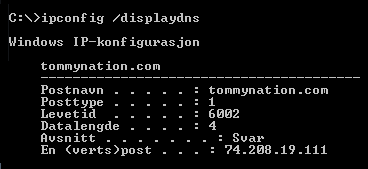Changing the name of a server inside of a domain? Finding computers whose names don’t match with their IPs? You may need to do some DNS “magic”.
If you get an error about “service not running” when using one of these commands on a server, you may simply need to reboot it, for example after a name change. This could also generate “untrusted domain” errors when connecting to SQL or similar services running on the server that rely on Windows Authentication to grant remote access from applications.
Commands to update DNS for any computer running Windows:
Open a Command Prompt (Run -> CMD or Start -> Programs -> Accessories. Right-click and select “Run as Administrator” if you experience problems).
ipconfig /displaydns
ipconfig /flushdns
ipconfig /registerdns

Commands for administration of a DNS server:
These mostly rely on the Resource Kit command line tool for DNS server administrators, known as DNSCMD.exe.
Right click the shortcut to Command Prompt and select “Run as administrator” before using DNSCMD.exe.
Tip: Add DNSCMD.exe to the System32 folder to be able to run it from any root in any command prompt window.
| Function | DNSCMD option | Example | Comments |
| Do any dnscmd command on a remote system | dnscmd servername command | dnscmd main.bigfirm.com /zoneprint bigfirm.com | |
| Create a primary zone | dnscmd /zoneadd zonename /primary | dnscmd /zoneadd bigfirm.com /primary | |
| Create a secondary zone | dnscmd /zoneadd zonename /secondary master IP address | dnscmd /zoneadd bigfirm.com /secondary 192.168.1.1 | |
| Host a zone on a server based on an existing (perhaps restored) zone file | dnscmd /zoneadd zonename /primary /file filename /load | dnscmd /zoneadd bigfirm.com /primary /file bigfirm.com.dns /load | |
| Delete a zone from a server | dnscmd /zonedelete zonename [/f] | dnscmd /zonedelete bigfirm.com /f | (without the /f, dnscmd asks you if you really want to delete the zone) |
| Show all of the zones on a DNS server | dnscmd /enumzones | dnscmd /enumzones | |
| Dump (almost) all of the records in a zone | dnscmd /zoneprint zonename | dnscmd /zoneprint bigfirm.com | Doesn’t show glue records. |
| Add an A record to a zone | dnscmd /recordadd zonename hostname A ipaddress | dnscmd /recordadd bigfirm.com mypc A 192.168.1.33 | |
| Add an NS record to a zone | dnscmd /recordadd zonename @ NS servername | dnscmd /recordadd bigfirm.com @ A dns3.bigfirm.com | |
| Delegate a new child domain, naming its first DNS server | dnscmd /recordadd zonename childname NS dnsservername | dnscmd /recordadd bigfirm.com test NS main.bigfirm.com | This would create the “test.bigfirm.com” DNS child domain unter the bigfirm.com DNS domain |
| Add an MX record to a zone | dnscmd /recordadd zonename @ MX priority servername | dnscmd /recordadd bigfirm.com @ MX 10 mail.bigfirm.com | |
| Add a PTR record to a reverse lookup zone | dnscmd /recordadd zonename lowIP PTR FQDN | dnscmd /recordadd 1.168.192.in-addr.arpa 3 A pc1.bigfirm.com | This is the PTR record for a system with IP address 192.168.1.3 |
| Modify a zone’s SOA record | dnscmd /recordadd zonename @ SOA primaryDNSservername responsibleemailipaddress serialnumber refreshinterval retryinterval expireinterval defaultTTL | dnscmd /recordadd bigfirm.com @ SOA winserver.bigfirm.com mark.bigfirm.com 41 1800 60 2592000 7200 | Ignores the serial number if it’s not greater than the current serial number |
| Delete a resource record | dnscmd /recorddelete zonename recordinfo [/f] | dnscmd /recorddelete bigfirm.com @ NS main.bigfirm.com /f | Again, “/f” means “don’t annoy me with a confirmation request, just do it.” |
| Create a resource record and incorporate a nonstandard TTL | dnscmd /recordadd zonename leftmostpartofrecord TTL restofrecord | dnscmd /recordadd bigfirm.com pc34 3200 A 192.168.1.4 | |
| Reload a zone from its zone file in \windows\system32\dns | dnscmd /zonereload zonename | dnscmd /zonereload bigfirm.com | Really only useful on primary DNS servers |
| Force DNS server to flush DNS data to zone file | dnscmd /zonewriteback zonename | dnscmd /zonewriteback bigfirm.com | |
| Tell a primary whom to allow zone transfers to | dnscmd /zoneresetsecondaries zonename /nonsecure|securens | dnscmd /zoneresetsecondaries bigfirm.com /nonsecure | That example says to allow anyone who asks to get a zone transfer |
| Enable/disable DNS NOTIFY | dnscmd /zoneresetsecondaries zonename /notify|/nonotify | dnscmd /zoneresetsecondaries bigfirm.com /nonotify | Example disables DNS notification, which is contrary to the default settings. |
| Tell a secondary DNS server to request any updates from the primary | dnscmd /zonerefresh zonename | dnscmd /zonerefresh bigfirm.com | |
| Enable or disable dynamic DNS on a zone | dnscmd /config zonename /allowupdate 1|0 | 1 enables, 0 disables, 0 is default | |
| Stop the DNS service | Either net stop dns or sc stop dns | (No dnscmd command for this) | |
| Start the DNS service | Either net start dns or sc start dns | (No dnscmd command for this) | |
| Install the DNS service on a 2008 full install system | servermanagercmd -install dns | ||
| Install the DNS service on a 2008 Server Core system | ocsetup DNS-Server-Core-Role | Case matters — ocsetup dns-server-core-role would fail | |
| Uninstall the DNS service on a 2008 Server full install system | servermanagercmd -remove dns | ||
| Uninstall the DNS service on a 2008 Server Core system | ocsetup /uninstall DNS-Server-Core-Role |
Credits to the source of this excellent list:
Mark’s Windows 2008 DNS Server Command Line Cheat Sheet.

